Up Next
Danielle Brathwaite-Shirley Uses Video Games to Archive the Black Trans Experience
The artist's immersive video game asks players to fight their inner demons.
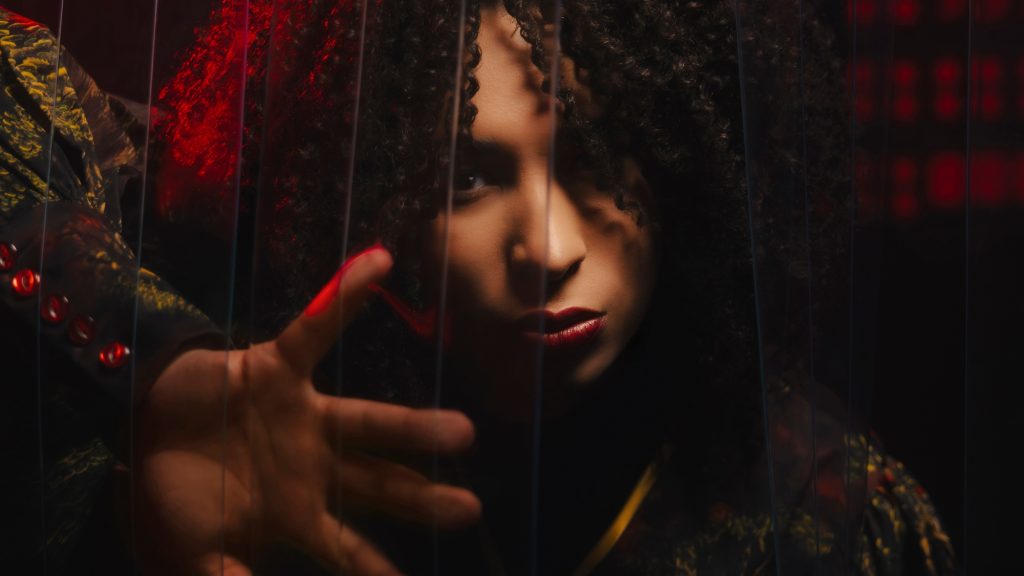
When did you last feel truly confronted by an artwork? For most, the art gallery is a site of escapism filled with attractive distractions. Not so, The Rebirthing Room, a new immersive video game installation by British artist Danielle Brathwaite-Shirley at Studio Voltaire in London. She proudly describes the work as “abrasive.”
The exhibition runs through April 28. Moving through a darkened forest, visitors are compelled towards the glowing red wrap-around game projected across three walls. Dare to step up to the controller and play? Be warned, this isn’t Mario Kart and nobody gets to be Princess Peach. Instead of selecting a cheerful avatar, you’ll start off by choosing which inner darkness you’re hoping to address. Options include self-doubt, anxiety, intolerance, and addiction, problems that will metamorphose into a demon figure that can only be vanquished if the player shines a light on them.
“There are so many things going wrong in the world that feel out of our control, but there are a lot of things that hold us back that we can decide to change,” explained Brathwaite-Shirley. “The game is designed to be hard and frustrating because all these things are really hard and frustrating to deal with.”
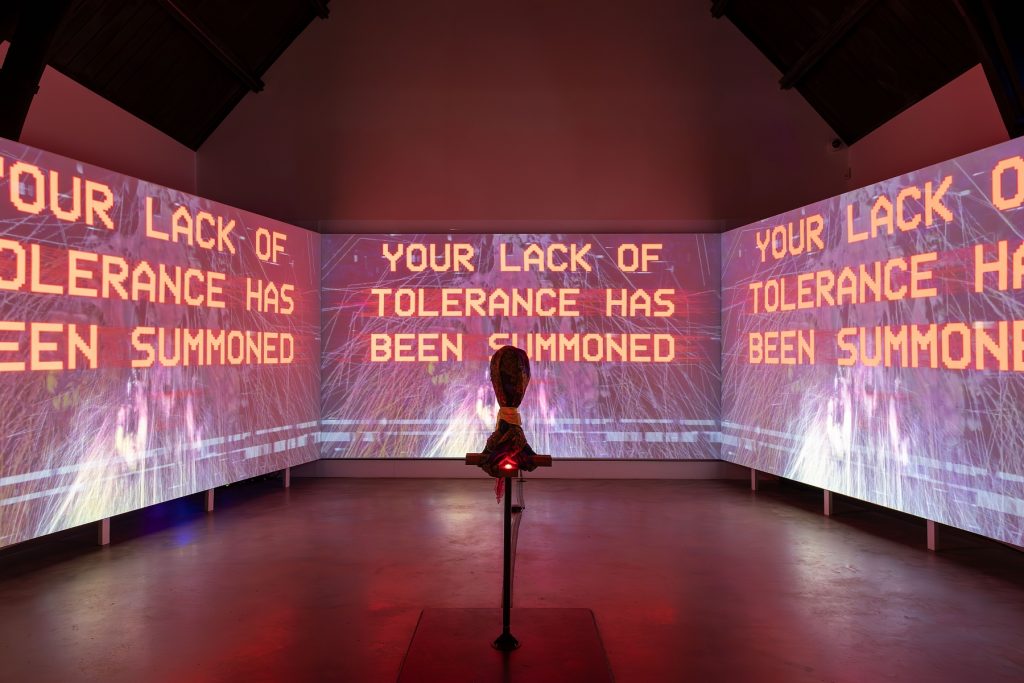
Danielle Brathwaite-Shirley, The Rebirthing Room (2024) at Studio Voltaire in London. Photo: Sarah Rainer.
Video games pull us out of a passive state and into a world that, much like our own, responds to our actions. The flowchart of possible outcomes that Brathwaite-Shirley mapped out in the early stages of the work’s development included the options of deciding not to play or walking in and immediately leaving. In this sense, you can’t actually avoid interacting with the game.
“The audience is my main medium,” said Brathwaite-Shirley. “They always surprise you, which is why it’s so exciting.” The surrounding installation of zany, zig-zagged “trees” also dissolve any clear demarcations between the game and the real world. “Otherwise, you can leave a lot of your emotions behind when you leave,” she added. “That’s a problem. I hope people will leave thinking introspectively.”
Visitors to The Rebirthing Room are entering a strange new world, yet one that paradoxically resembles the more private recesses of the mind. This is a change of tack for Brathwaite-Shirley, who has more often pushed players into jarringly unfamiliar places. One of her earliest works to make a major splash on the digital art scene was the online video game The Black Trans Archive. Its content was generated during meetings between around 15 Black trans friends of Brathwaite- Shirley’s. For some white and cis players, it was the first time they’d seriously contemplated everyday experiences like being stared at.
“I didn’t want to make it like a traditional archive because they are really inaccessible,” said Brathwaite-Shirley. “Its hard to figure out what you want to see unless you know exactly what you’re looking for. I wanted the archive to be alive.”
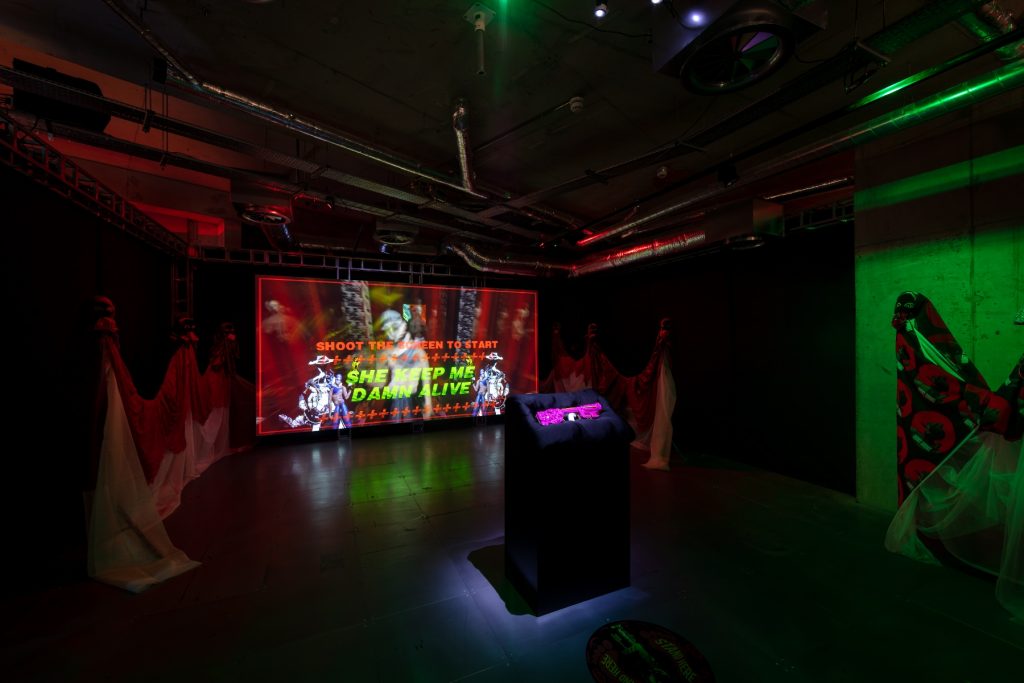
Danielle Brathwaite-Shirley, She Keeps Me Damn Alive (2021) at Arebyte Gallery in London. Photo: Dan Weill.
One work that grew out of this project was She Keeps Me Damn Alive (2021), which debuted at the non-profit Arebyte Gallery in London. The game’s controller was a large bubblegum pink gun and visitors were encouraged to use it only when absolutely necessary to protect Black trans lives. How trigger happy would they become? “You go through these levels, everyone’s dancing, it’s very beautiful, but you’re very tense with the gun because you know you have to act but you don’t know when. Everyone looks like a monster,” said Brathwaite-Shirley. “The point is, I don’t think you can use a weapon to protect any group of people without harming that group. The work is an anti-violence gun game.”
The decades-long association between violence and video games has been raised and refuted time and again. For Brathwaite-Shirley who was born in London in 1995 and grew up loving video games, there is a personal resonance. One time she was deep into playing Metal Gear Solid 2 (2001) when she shot someone. “Then I realized I didn’t need to, I hadn’t done that for five hours. The things I did I would feel bad about,” she recalled, but it was exciting to interrogate these choices.
Back then, gaming was just a hobby and Brathwaite-Shirley dreamt of becoming a theoretical physicist. She accepted an offer to study Physics at university and the future seemed set. That was, until Brathwaite-Shirley accompanied a love interest to an open day for the art foundation program at Kingston University. “I was so impressed that I delayed my place,” she recalled. In 2019, she graduated with a BFA from the Slade, where she had mastered the art of animation.
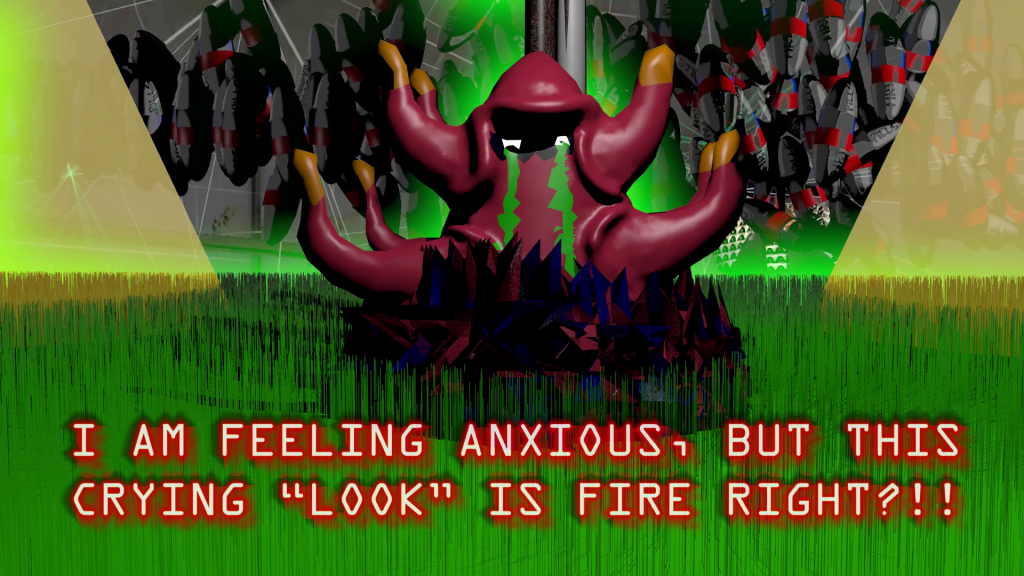
Danielle Brathwaite-Shirley, Unarchived Adventures (2019). Image courtesy of the artist.
Presented at her degree show, Digging for Black Trans Love (2019) satirized the tendency to mine trans people for stories of trauma and was filled with eye-catching graphics. “Someone told me that they liked this animation because they could bathe in the imagery and ignore what I’m trying to say,” said Brathwaite-Shirley. This was the final push she needed to start making video games, which would turn placid viewers into active participants.
She would have to teach herself all the necessary skills from scratch, working alongside an experienced programmer. For each project Brathwaite-Shirley experiments with a different game engine, each of which have their own structure or preferred data types. “The engine limits your choices,” she explained. “I have to reconsider everything I considered the first time I made a game. What’s the controller method? How will the audience use it?” The controller also needed to be something her mother could use. “If you don’t take that into consideration, you’re basically in a gallery context but your access point is a game context,” Brathwaite-Shirley explained. “There’s a disconnect there.”
The look was inspired by a niche internet subgenre known as “analogue horror” that favors a glitchy, grainy, VHS-style aesthetic. “It’s very textured, the quality is low, and you have to use your imagination a bit more,” Brathwaite-Shirley explained. “Who is this person? Why do they look like that? What does this movement mean? It adds to the uneasiness of it.”
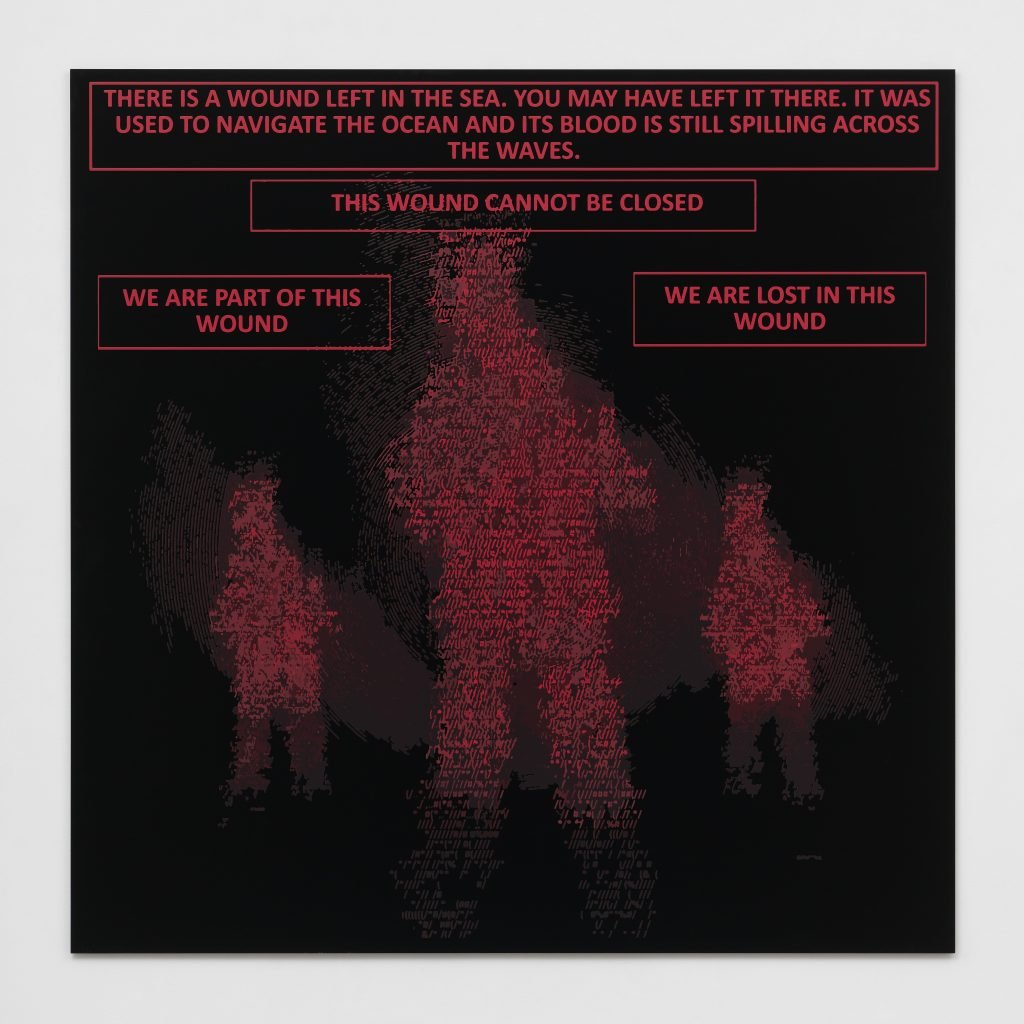
Danielle Brathwaite-Shirley, Part of the Wound (2022). Photo: Flying Studio. Courtesy of the artist and David Kordansky Gallery
One particularly personal video game was Get Home Safe (2022). It recreates the frequent experience of being followed at night after Brathwaite-Shirley moved to Berlin, where she is now based. Drivers would slow down and try to get her inside their cars so she pretended to be on the phone. “I didn’t have anyone to call, so I would just sing songs into my phone,” she recalled. “The game basically documented me trying to get home safe. Some people really cried at that one. It was the first time that I realized some of these things that felt unique to my experience are very universal.”
Using the Blender Game Engine—”a terrible, abandoned game engine”—Brathwaite-Shirley created Get Home Safe using only ASCII, the earliest computer game graphics from the late 1970s. You’ve used it too if you’ve ever made images from keyboard characters like <3 or :). Once again, the player is responsible for decisions like whether or not to get into a passing car and these choices determine how the scenes evolve. To survive, the player must constantly scan the streets around them as ambiguous entities approach from all sides. “It was a horror game and you could fail very easily,” said Brathwaite-Shirley.
Aside from some audience members being challenged by the content of Brathwaite-Shirley’s video games, others don’t see interactive media as having a place in the traditional art gallery. “I get people who immediately say, I don’t play games, I don’t think this is for me. That feels like snobbery,” she said, speculating that this may be related to our conception of games as a commercial product. “In the gaming world, we do consider games pieces of art. If it’s a masterpiece, we’ll say so.”
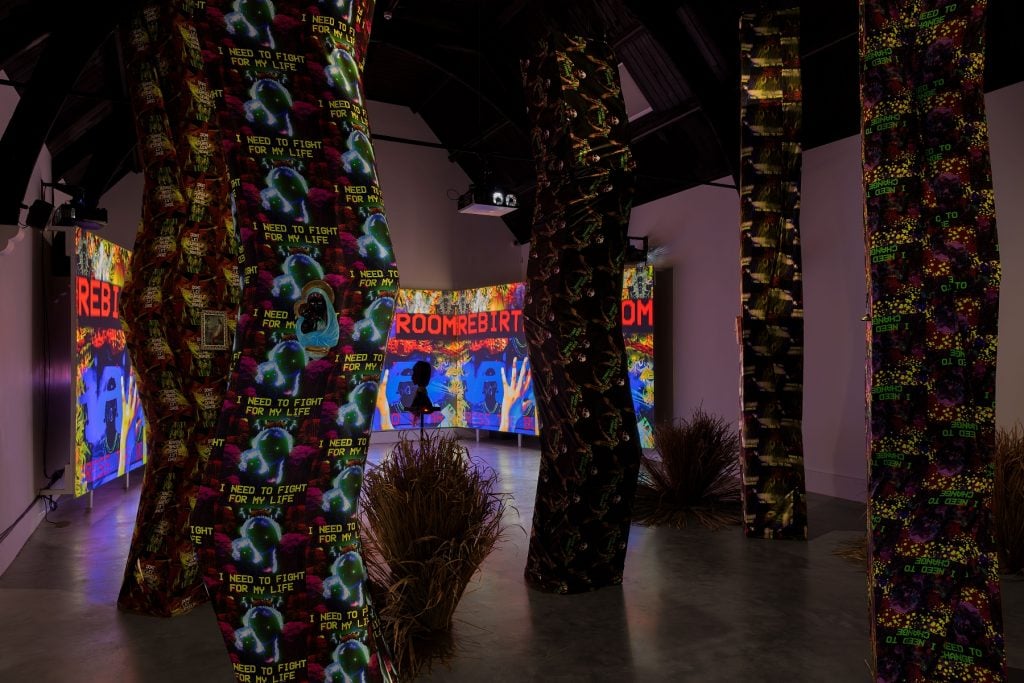
Danielle Brathwaite-Shirley, The Rebirthing Room (2024) at Studio Voltaire in London. Photo: Sarah Rainer.
Attitudes are slowly shifting, and Brathwaite-Shirley has had a string of projects backed by top institutions. Her 2020 game I Can’t Remember A Time I Didn’t Need You was acquired by the V&A in 2022. The new tongue-in-cheek work Cancel Yourself is currently featured in Sound Machines, an online exhibition presented by MoMA and Feral File.
For now, Brathwaite Shirley is keeping tauntingly tight-lipped about a few upcoming projects. Of a major survey by LAS Art Foundation in Berlin this summer, she said: “You know that age old scene in horror movies where there’s something in the basement? And you’ve got to walk down the stairs. That should be the feeling of the show.” Another exhibition at the Miró Foundation in Barcelona will, apparently, be about burnt bodies. “The premise is to get you to leave the gallery.”
The Rebirthing Room runs at Studio Voltaire in Clapham, London through April 28, 2024. This summer Danielle Brathwaite-Shirley will have a major survey commissioned by LAS Art Foundation at Halle am Berghain, Berlin.





